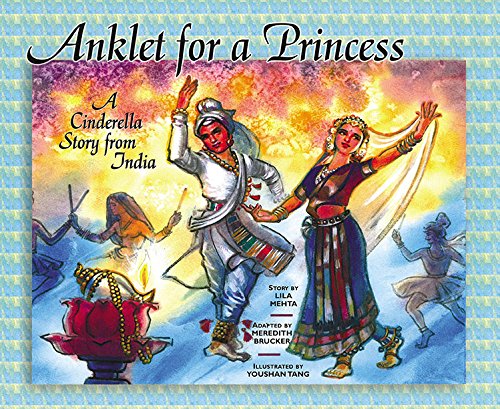
Anklet for a Princess
Written by Lila Mehta
Adapted by Meredith Brucker
Illustrated by Youshan Tang
Shen’s Books, 2002, 32 pp.
ISBN: 978-1885008466
Lila Mehta and Meredith Brucker tell a Cinderella story set in ancient India. After the death of her father, Cinduri lives with her stepmother and stepsister, Lata. Her duties include cleaning the house, milking cows, and tending to the vegetable garden and farm animals. One day, she meets a snake with whom she develops a valuable relationship. Due to the snake’s presence and intervention, she eventually breaks free of her stepmother and Lata’s rule.
Youshan Tang’s watercolor illustrations can be described as concise. They do not contain much detail about the setting but focus on just the character(s) who are active at that point in the story. They reinforce, rather than augment, the written text.
Scholars Botelho and Rudman (2009) state, “Since there is estimated to be over 1,000 versions across the world, the criteria for beauty vary” (p. 227). In this book, Cinduri is described as wrapped in cloths of the purest gold threads, while magnificent jewels adorn her hair and throat. At the Navaratri Festival, she catches the eye of the crowd, most importantly the prince. In her culture, riches are the standard of beauty. This standard of beauty mirrors Western culture in that jewels and expensive items are often deemed attractive. The authors offer the audience a mirror to reflect upon their individual standards of beauty and how society sways these standards.
Mehta and Brucker provide the audience with a window to access Cinduri’s journey. When reading the picturebook, the audience must take into consideration how the ideologies of gender and Indian culture shape her journey. She meets a snake who takes on the role of her Godfather and acts as a magical advisor, providing her with fresh water and supplying the riches which win the prince’s heart. The snake is a traditional Hindu symbol of strength and might. Of all the Asian Cinderellas, according to Botelho and Rudman (2009), this story is most reminiscent of European tales. The European ideology of gender, therefore, shapes this Cinderella story. In such stories, “Cinderella is deliberately and doggedly kind, as if these qualities function as resistance along the path for acquiring agency” (Botelho & Rudman, 2009, p. 224). Cinduri remains loyal and submissive to her stepmother and Lata, despite their continued abuse. The snake rewards her loyalty and rescues her from her oppressive stepfamily. The story ends with her happily married to the prince, but has she achieved true agency? After their wedding, the prince informs her, “My father has built us a beautiful palace.” Although Godfather Snake may live in their palace, Cinduri does not seem to have a voice in choosing her home. Since men hold the power, she is seemingly beholden to the agency of her husband. After accessing Cinduri’s world through windows, the audience can engage with questions about gendered expectations, class, and beauty.
To compare gender roles and beauty standards, upper-elementary teachers can pair An Anklet for a Princess with Robert San Souci’s (1998) Cendrillon: A Caribbean Cinderella and Tomie de Paola’s (2004) Adelita: A Mexican Cinderella Story. Students can use these comparisons to create a multimedia collage of representations of gender across such media as magazine clippings, social media ads, and TV commercials (Botelho & Rudman, 2009, p. 236). The unit can culminate with students re-imagining one of these Cinderella stories through modern-day norms and ideologies.
Lila Mehta was born in India and settled in Canada with her family. Before becoming an author educator, she worked as a nurse and midwife. Meredith Brucker lives in Southern California. In addition to writing books for children and adults, she has written for TV networks, newspapers, and magazines. Youshan Tang was raised China and settled in San Francisco. He holds degrees in art and literature. He has illustrated many children’s books pertaining to Asian culture.
Reference:
Botelho, M.J. & Rudman, M.K. (2009). Critical multicultural analysis of children’s literature: Mirrors, windows, and doors. New York, NY: Routledge.
LaShanda Francis, University of Houston-Victoria
WOW Review, Volume XIII, Issue 1 by Worlds of Words is licensed under a Creative Commons Attribution-NonCommercial-ShareAlike 4.0 International License. Based on work by LaShanda Francis at https://wowlit.org/on-line-publications/review/volume-xiii-issue-1/3/
WOW review: reading across cultures
ISSN 2577-0527
